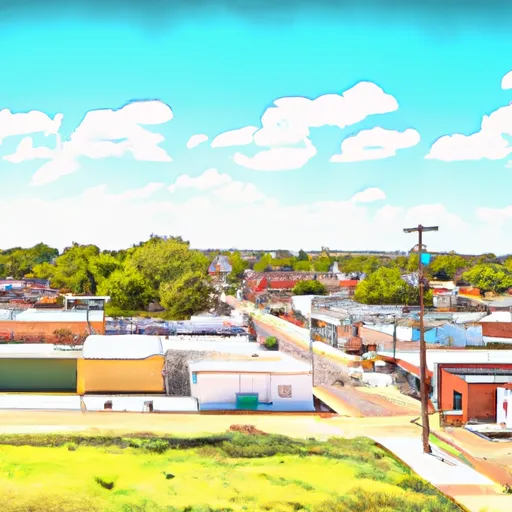-
 Snoflo Premium
Snoflo Premium
Get unlimited access to all our content
With no Ad interruptions! - Start Your Free Trial Login with existing account
Krebs
Eden Index
Climate
8.3
•
Recreation
0.9
•
Community
2.0
•
Safeguard
4.1/10

Krebs, Oklahoma is a small town located in Pittsburg County in the southeastern part of the state. The climate in Krebs is characterized by hot summers and mild winters. Summers are typically hot and humid, with temperatures often reaching the high 90s°F (mid 30s°C). Winters are relatively mild, with average temperatures in the 40s°F (4-9°C). The area receives a moderate amount of rainfall throughout the year, with occasional thunderstorms during the summer months.
Hydrologically, Krebs is situated in the Fourche Maline Creek watershed, which eventually drains into the Arkansas River. The creek and its tributaries provide water resources in the region.
Outdoor recreation opportunities in Krebs and its surrounding areas are plentiful. The town is located near extensive forested areas, including the Ouachita National Forest, which offers various activities such as hiking, camping, fishing, and hunting. Additionally, nearby lakes and rivers, such as Lake Eufaula and the Kiamichi River, provide opportunities for boating, fishing, and water sports. Krebs is also known for its rich coal mining history, and visitors can explore the Krebs Heritage Museum and learn about the town's past.
What is the Eden Index?
The Snoflo Eden Index serves as a comprehensive rating system for regions, evaluating their desirability through a holistic assessment of climate health, outdoor recreation opportunities, and natural disaster risk, acknowledging the profound impact of these factors on livability and well-being.
Climate Health Indicator (CHI): 8.3
Krebs receives approximately
1113mm of rain per year,
with humidity levels near 83%
and air temperatures averaging around
17°C.
Krebs has a plant hardyness factor of
7, meaning
plants and agriculture in this region tend to thrive during the non-winter months.
By considering the ideal temperature range, reliable water supplies, clean air, and stable seasonal rain or snowpacks, the Climate Health Indicator (CHI) underscores the significance of a healthy climate as the foundation for quality living.
A healthy climate is paramount for ensuring a high quality of life and livability in a region, fostering both physical well-being and environmental harmony. This can be characterized by ideal temperatures, reliable access to water supplies, clean air, and consistent seasonal rain or snowpacks.
Weather Forecast
Streamflow Conditions
Lower Canadian
Area Rivers
Lower Canadian
Snowpack Depths
Lower Canadian
Reservoir Storage Capacity
Lower Canadian
Groundwater Levels
Recreational Opportunity Index (ROI): 0.9
The Recreational Opportunity Index (ROI) recognizes the value of outdoor recreational options, such as parks, hiking trails, camping sites, and fishing spots, while acknowledging that climate plays a pivotal role in ensuring the comfort and consistency of these experiences.
Access to outdoor recreational opportunities, encompassing activities such as parks, hiking, camping, and fishing, is crucial for overall well-being, and the climate plays a pivotal role in enabling and enhancing these experiences, ensuring that individuals can engage in nature-based activities comfortably and consistently.
Camping Areas
| Campground | Campsites | Reservations | Toilets | Showers | Elevation |
|---|---|---|---|---|---|
| Sanders Cove - Pat Mayse Lake | 90 | 541 ft | |||
| Murphys Meadow Military - McAlester | None | 725 ft | |||
| Pat Mayse East - Pat Mayse Lake | 25 | 504 ft | |||
| McGee Creek State Park | None | 684 ft | |||
| Lake McAlester | None | 626 ft | |||
| Oak Ridge - Eufaula Lake | None | 597 ft | |||
| Pat Mayse West - Pat Mayse Lake | 85 | 481 ft | |||
| Arrowhead State Park | None | 619 ft | |||
| Elm Point - Eufaula Lake | None | 599 ft | |||
| Lamar Point - Pat Mayse Lake | None | 506 ft |
Nearby Fishing
Catastrophe Safeguard Index (CSI):
The Catastrophe Safeguard Index (CSI) recognizes that natural disaster risk, encompassing floods, fires, hurricanes, and tornadoes, can drastically affect safety and the overall appeal of an area.
The level of natural disaster risk in a region significantly affects safety and the overall livability, with climate change amplifying these risks by potentially increasing the frequency and intensity of events like floods, fires, hurricanes, and tornadoes, thereby posing substantial challenges to community resilience and well-being.
Community Resilience Indicator (CRI): 2.0
The Community Resilience Indicator (CRI) recognizes that education, healthcare, and socioeconomics are crucial to the well-being of a region. The CRI acknowledges the profound impact of these elements on residents' overall quality of life. By evaluating educational resources, healthcare accessibility, and economic inclusivity, the index captures the essential aspects that contribute to a thriving community, fostering resident satisfaction, equity, and social cohesion.

